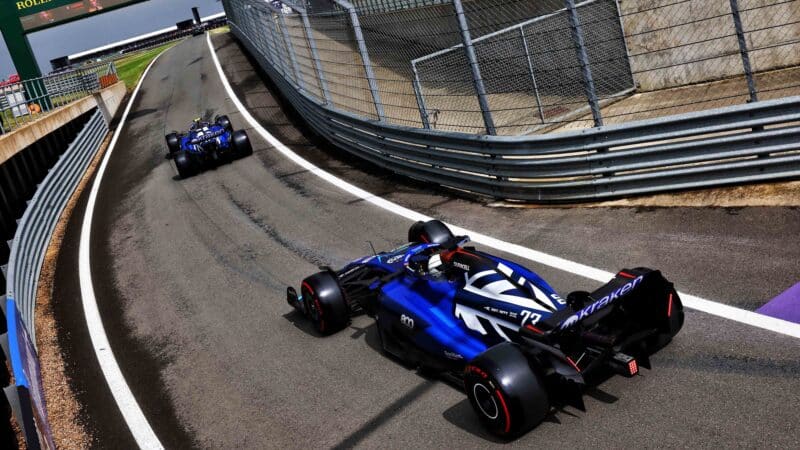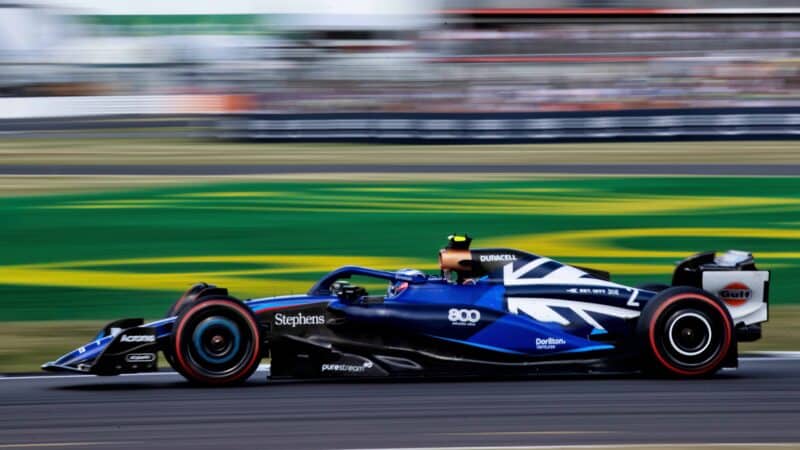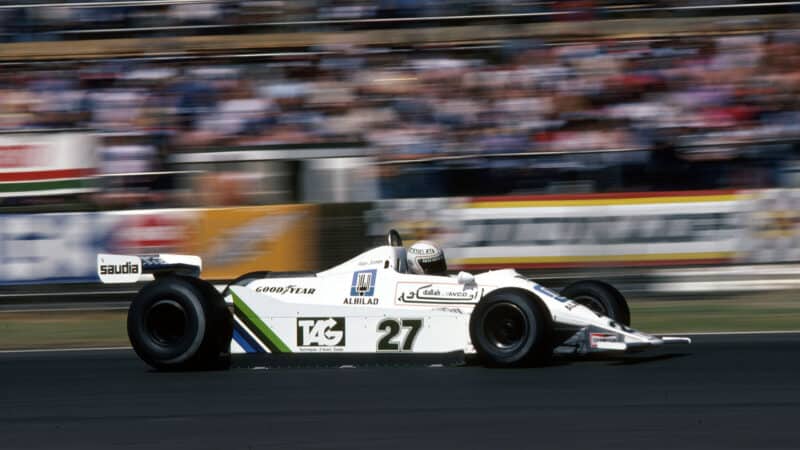A glimpse of Williams' F1 recovery, at its spiritual Silverstone home
F1 Retro
Silverstone marked the arrival of Williams as an F1 grand prix winner, writes Mark Hughes. It witnessed dominant victories in the constructor's glory days and, last weekend, it saw a (temporarily) resurgent team celebrating its imminent 800th GP.

Williams
Silverstone is a very different aerodynamic challenge today to how it was in previous decades. It’s no longer really about fast corner performance. Sure, the circuit is still largely composed of fast corners, punctuated by a few low-speed flicks. But those fast corners are barely even recognised as such by the modern cars. In qualifying at least, even a poor car is pretty much flat thrtough Abbey, Copse, Maggotts. Even Stowe is essentially just a lift.
So high-speed aero performance, as in how much downforce a car has relative to its rivals through fast corners, is not really much of a differentiator here. In fact, if you are a little light on downforce and are habitually fast on the straights as a result, you’ll be fast through Silverstone’s high-speed corners too. Silverstone is now a low-drag track, not a downforce track, and has been for a few years.
Which is not to belittle the great job Alex Albon did through last weekend’s British Grand Prix, when he had the Williams absolutely flying, top-three in the Friday practices, comfortably making it through to Q3 and out-qualifying Fernando Alonso’s Aston Martin there.

Williams was flying in what should have been its 800th grand prix
Williams
The team has made progress year-on-year, but is realistically still vying – with AlphaTauri and Alfa Romeo – not to be the slowest on conventional tracks. But the run of Montreal–Austria–Silverstone, three consecutive drag-prioritising circuits, has allowed Albon to make a real impression. At Silverstone, he was still trying to pass Alonso’s Aston for seventh as they took the flag, having overtaken Charles Leclerc’s Ferrari on-track.
This was supposed to be Williams’ 800th grand prix (since its relaunched 1977 incarnation) but the cancellation of Imola has delayed that milestone until Hungary next week. There had been a Williams team before Frank Williams and Patrick Head began their new venture together with a customer March at the ’77 Spanish Grand Prix. It had actually been around since ’69 and had even designed and built its own Williams cars subsequently, but that team came to be owned by someone else (and eventually died in ’82). That broke the lineage, so this Williams team is deemed to have begun in Spain ’77 a few races after Walter Wolf had bought the former Williams team and rebranded it as Wolf.
Experience the full, thrilling stories of two motor sport legends: the Ford Sierra RS500 and Williams Racing — now immortalised in slot car form

The team that made its inauspicious debut at Jarama ’77 came to bestride the sport in the ‘80s and ‘90s, making world champions out of Alan Jones, Keke Rosberg, Nelson Piquet, Nigel Mansell, Damon Hill and Jacques Villeneuve. But fittingly the breakthrough race victory was at Silverstone in ’79. The place came to have a special resonance with the team and that was the beginning.
Back then the track’s layout was quite different to that we know today and for the cars of the time – the first generation of ground effect machines – it was a supreme test of high-speed downforce. In fact that’s where the spectacular gains had been made, as testified by the incredible 1min 11.88sec pole position of Jones in the Williams FW07. Two years earlier, James Hunt in a McLaren M26 with the same Cosworth DFV power as enjoyed by Jones had put his car on pole with a 1min 18.49sec lap. Ground effect had slashed almost 7sec off Silverstone lap times – and Williams was the cutting edge of it.
Patrick Head had conceived a better, more structurally rigid version of the ’78 title-winning Lotus 79. A great mechanical engineer, he also had a much fuller understanding than his contemporaries of the structural requirements of a car capable of generating such massive downforce. The team’s (only) aerodynamicist Frank Dernie had been let loose on keeping the airflow attached around the back of the car and just before Silverstone had come up with a fenced off section around the gearbox which did the job to spectacular effect, joining up the underfloor flow exiting the diffuser to the underside of the rear wing.

Alan Jones retired from the lead in 1979, leaving Regazzoni to claim Williams’ first GP win
Hoch Zwei/Getty images
As a paying punter I watched Jones through that weekend and he became visibly bolder each time he took to the track, as if re-calibrating what was possible around Silverstone’s fast sweeps. To see him through Copse, entry speed of a different order to anything else, spectacular oversteer from mid corner, throttle foot buried, was special indeed. Together, he and the FW07 were emerging in a spectacular synergy as F1’s new gold standard combination. This was the weekend when this became very, very clear, even though it was team-mate Clay Regazzoni who took Williams’ first grand prix win the next day, after Jones’ water pump leaked away the coolant when leading comfortably.
So many more legendary Williams Silverstone days were to come. Keke Rosberg’s first 150mph pole lap in the turbocharged FW10 of 1985, slow puncture and damp track not enough to induce Keke into backing off, car twitching menacingly as soon as he changed direction. The exclusively Williams breathtaking battle between Mansell and Piquet in ’87, Nigel’s infamous double swerve into Stowe to take the lead, fuel read-out reading zero, the crowd erupting. Mansell’s pass on Ayrton Senna’s McLaren – also at Stowe – in the early laps of the ’91 race on his way to victory. The crushingly dominant pole and victory of ’92 in the active ride FW14B, a car with probably the biggest level of superiority over its rivals ever seen. Yet more dominant days in the Silverstone sun in the years to come, with Alain Prost, Damon Hill, Jacques Villeneuve.

Damon Hill won for Williams in ’94
Mirrorpix/Getty Images
And then it stopped. Oh, there were occasional bursts of speed in the BMW part of the 2000s, as the kindling of Williams’ magic re-ignited briefly. But the energy just ran out. In hindsight, letting Adrian Newey go in ’97 (he’d joined in ’90) was probably a catastrophic error of judgement. Furthermore, the team’s structure and processes just did not keep up with the massive expansion of the teams in the 2000s and keeping the plates spinning was more than Frank and Patrick could do, especially as there was no adequate succession plan. And it gradually dwindled to almost nothing, a team hanging off the back of the grid by 2019, its absolute nadir.
But there’s money available now and there’s a team principal in James Vowles who understands how it needs to be spent. In Alex Albon it has the perfect guy to rebuild the team around. So long as they can hang onto him. That fighting eighth place on Sunday could be the beginning of the rebirth, but it will be a rather longer process than in ’79.
Scalextric Williams Race set
£139.99
Put Williams back on the top step of the podium with the latest Scalextric F1 race set. Battle with two Williams FW45 cars — one with Gulf livery — on a track with four layout options and lap counter.


